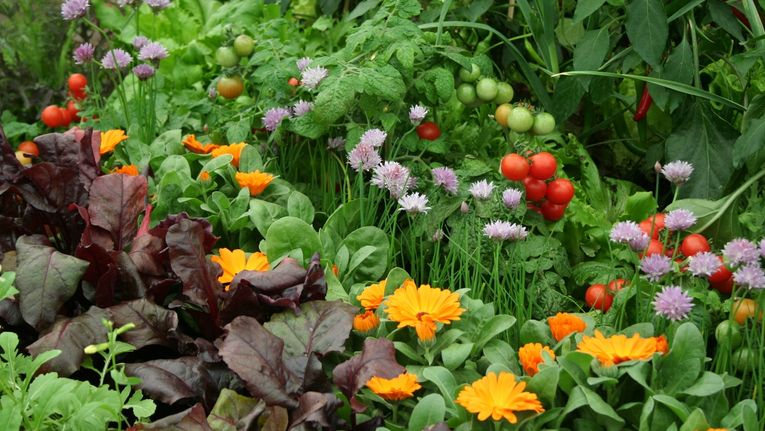Are you an avid gardener or someone who is just starting out in the world of gardening? If so, you might be wondering if it’s possible to plant flowers next to your vegetables. In this article, we’ll explore the topic of whether it’s okay to mix flowers and vegetables in your garden. By the end, you’ll have a better understanding of the potential benefits and drawbacks of combining these two types of plants. So, let’s dig in and discover if planting flowers next to vegetables is a good idea for your garden!
Can I Plant Flowers Next to Vegetables?
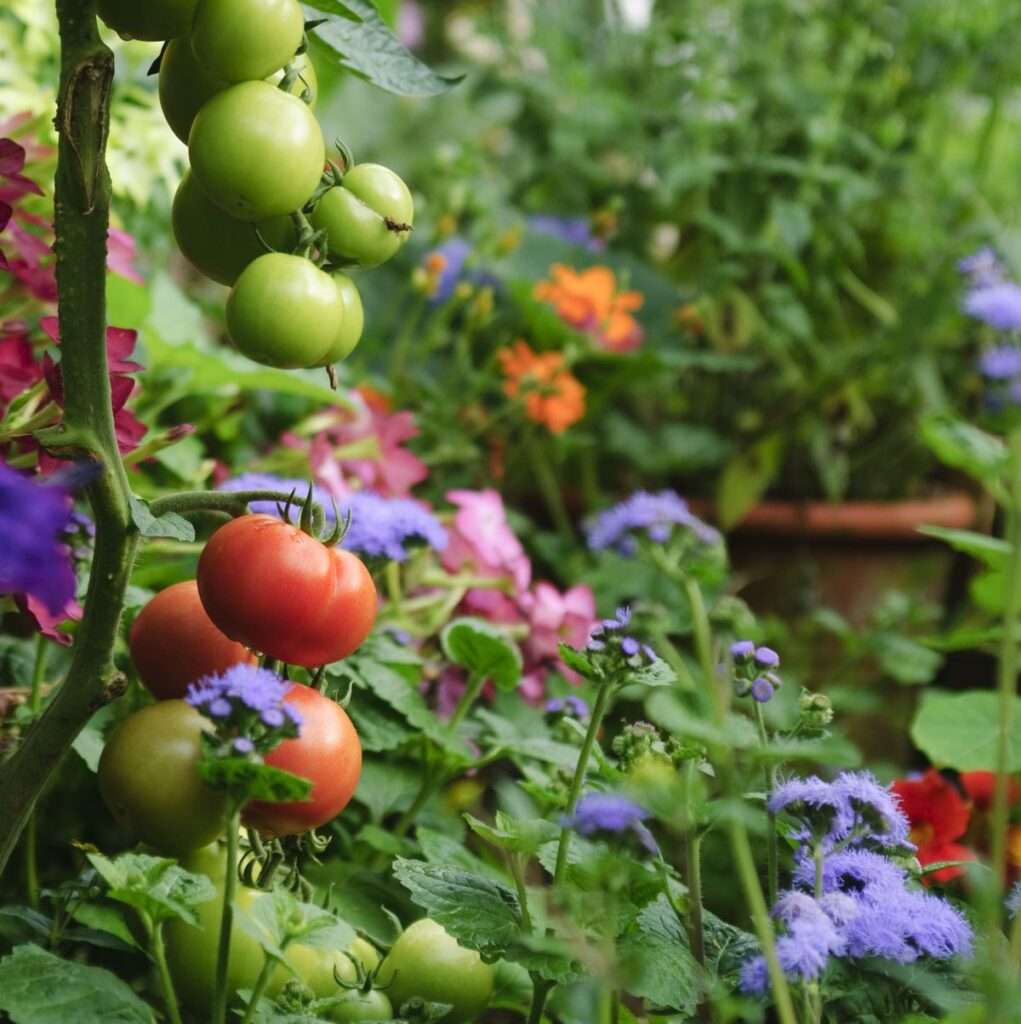
Introduction
Importance of gardening
Gardening is a fulfilling and enriching activity that allows you to connect with nature, grow your own food, and create beautiful outdoor spaces. Not only does it provide a sense of accomplishment, but it also offers numerous physical and mental health benefits. One aspect of gardening that often sparks curiosity is the idea of planting flowers next to vegetables.
Exploring off-grid living
Off-grid living is a lifestyle choice that involves disconnecting from traditional utility services such as electricity, water, and sewer systems. It is a way to live self-sufficiently and reduce dependence on mainstream resources. Many off-grid enthusiasts also embrace the principles of sustainable living and eco-friendliness, which often includes organic gardening practices.
Understanding Companion Planting
Definition and benefits of companion planting
Companion planting is a practice that involves growing certain plants together because they provide mutual benefits to each other. It takes advantage of the natural harmonies that exist between different plants, creating a more balanced and resilient garden ecosystem. Some plants have the ability to enhance the growth, health, and productivity of neighboring plants by repelling pests, attracting beneficial insects, or improving soil fertility.
How companion plants enhance vegetable growth
When it comes to vegetable gardening, companion planting can significantly improve the overall health and yield of crops. For example, certain flowers can act as natural pest repellents, keeping destructive insects away from your precious vegetables. Other companion plants can attract pollinators, such as bees and butterflies, which are essential for the successful pollination and fruit set of many vegetable plants.
Examples of popular companion plants
There are numerous examples of popular companion plants that have proven to be beneficial when planted next to vegetables. For instance, marigolds are known for their ability to repel nematodes and other harmful soil-dwelling insects, making them an excellent companion for tomatoes. Nasturtiums, with their vibrant flowers, not only add beauty to the garden but also attract aphids away from cucumbers. Lavender, on the other hand, can deter pests like aphids, thrips, and whiteflies, making it a suitable companion for peppers.
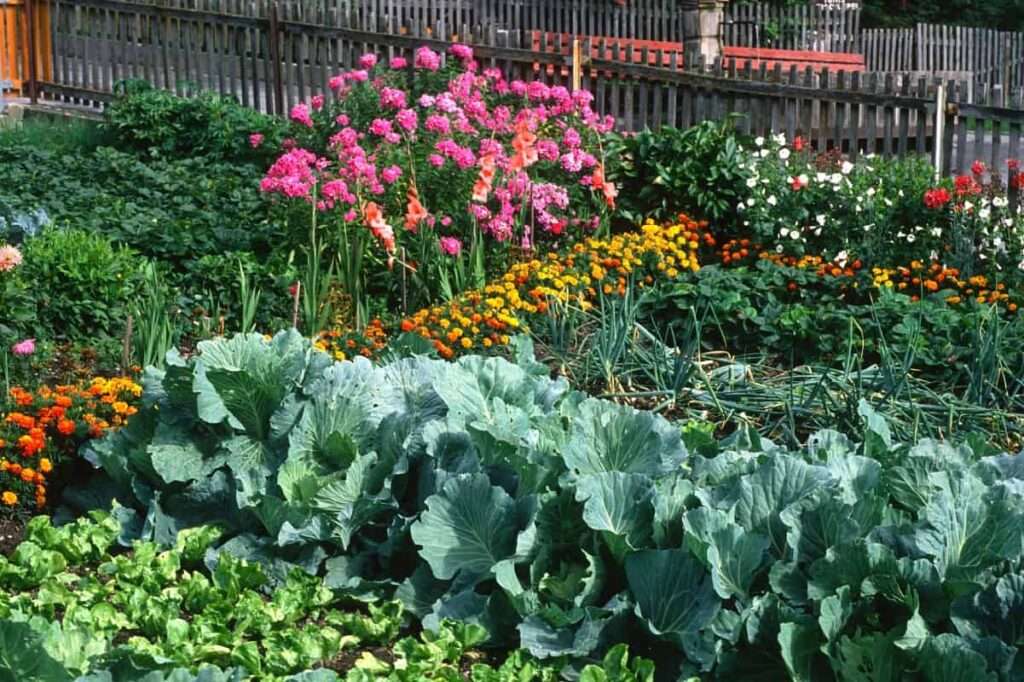
Considerations for Planting Flowers Next to Vegetables
Competing for resources: Water, nutrients, and sunlight
When planting flowers next to vegetables, it is important to consider the potential competition for resources such as water, nutrients, and sunlight. Some flowers, particularly those with vigorous growth habits, may draw nutrients away from the neighboring vegetables. Similarly, taller flowers with large foliage can shade the vegetables, limiting their access to sunlight. Proper planning and selection of companion plants can help mitigate these challenges.
Factors to consider when selecting companion flowers
When choosing companion flowers, consider their growth habits, water and nutrient requirements, and their potential impact on the neighboring vegetables. Opt for flowers that have compatible needs and can coexist harmoniously with the vegetable plants. Additionally, selecting flowers that bloom at different times can provide a continuous food and habitat source for beneficial insects throughout the growing season.
Compatibility of flower and vegetable species
While companion planting offers many benefits, it is essential to be mindful of the compatibility between flower and vegetable species. Some plants may produce chemicals or compounds that can hinder the growth or development of neighboring plants. Researching compatibility charts or consulting gardening experts can help you make informed decisions when selecting flower-vegetable combinations.
Benefits of Planting Flowers with Vegetables
Natural pest control
One of the most significant advantages of planting flowers next to vegetables is natural pest control. Many flowers, such as marigolds, chrysanthemums, and nasturtiums, contain compounds that repel insects and deter pests. By interplanting these flowers with your vegetables, you can reduce the need for chemical pesticides and create a more balanced ecosystem in your garden.
Attracting beneficial insects
Flowers are not only attractive to pests but also to beneficial insects that play a crucial role in maintaining a healthy garden. Bees, butterflies, ladybugs, and hoverflies are just a few examples of beneficial insects that are important for pollination and pest control. By planting flowers that are known to attract these beneficial organisms, you can boost their numbers and create a more vibrant and biodiverse garden.
Enhancing pollination
Pollination is essential for the successful reproduction of many vegetable plants. Some flowers, such as zinnias, cosmos, and sunflowers, attract pollinators with their nectar-rich blooms, increasing the chances of efficient pollination for your vegetable crops. A garden with a variety of flower species can ensure a consistent and robust pollinator population, leading to better yields and fruit formation.
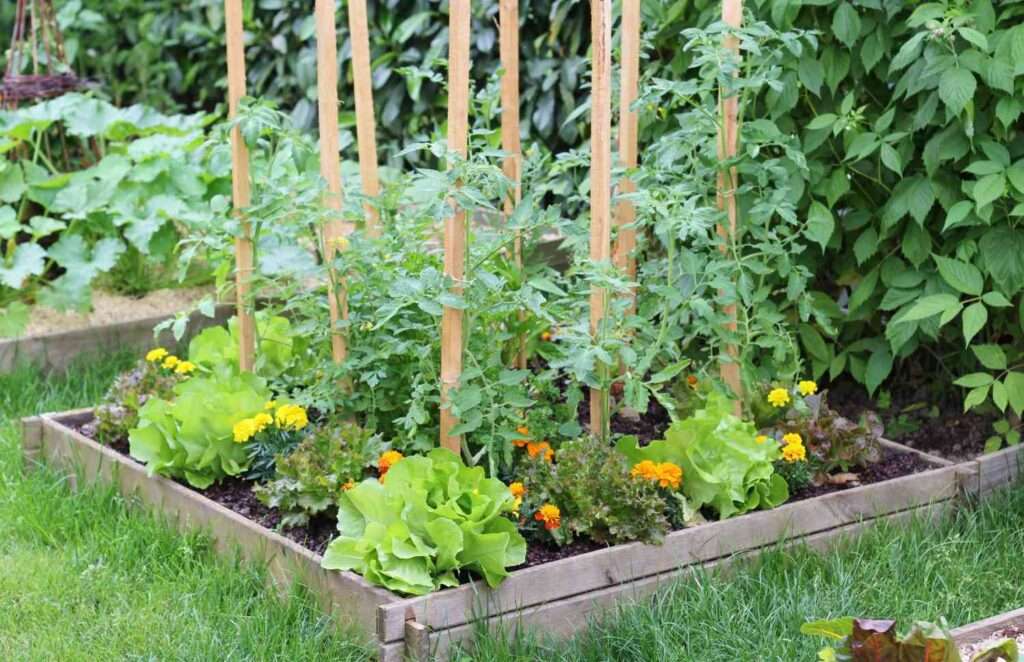
Examples of Flower-Vegetable Combinations
Marigolds and tomatoes
Marigolds and tomatoes make a classic pair in the garden. The pungent scent of marigolds repels nematodes and other soil-borne pests that commonly affect tomatoes. Additionally, marigolds attract hoverflies, ladybugs, and other beneficial insects that prey on aphids and other tomato pests.
Nasturtiums and cucumbers
Nasturtiums are not only beautiful with their vibrant flowers but also serve as a functional companion for cucumbers. They act as a sacrificial trap crop, luring aphids away from cucumber plants. This helps protect the cucumbers from aphid damage and also attracts beneficial insects that feed on aphids, providing natural pest control.
Lavender and peppers
Lavender is a fragrant flowering plant that can help deter pests like aphids, thrips, and whiteflies. Planting lavender alongside peppers can create a barrier that keeps these pests at bay. Additionally, bees are attracted to the aromatic flowers of lavender, aiding in the pollination of peppers and promoting fruit development.
Creating a Flower-Vegetable Garden Layout
Complementary aesthetics and design
When planning a flower-vegetable garden layout, consider the aesthetic appeal and design of the overall space. Choose flowers that complement the colors and textures of the vegetables, creating an attractive and visually pleasing garden. Grouping plants with similar growth habits or colors can also create visual harmony and balance.
Considerations for spacing and size
Ensure that you provide ample spacing between the flowers and vegetables to avoid overcrowding and competition for resources. Different plants have varying space requirements, so it is crucial to research and understand the recommended spacing for each species. Additionally, consider the mature size of each plant when planning the layout to avoid overshadowing or shading of the vegetables.
Implementing intercropping techniques
Intercropping is a gardening technique that involves growing two or more crops together in the same space. By intercropping flowers and vegetables, you can maximize space utilization and increase biodiversity in your garden. For example, you can plant low-growing flowers like marigolds or alyssum between rows of taller vegetables to utilize the vertical space effectively.
Best Practices and Tips
Proper soil preparation
Before planting flowers and vegetables, ensure that the soil is adequately prepared. Clear the area of weeds, loosen the soil with a garden fork, and amend it with organic matter, such as compost or aged manure. This will provide a nutrient-rich and well-draining environment for both the flowers and vegetables to thrive.
Maintaining appropriate moisture levels
Proper watering is crucial for the health and growth of your plants. Flowers and vegetables may have different water requirements, so it is important to find a balance that suits both. Keep the soil consistently moist but not waterlogged. Mulching can help retain moisture in the soil and reduce water evaporation, contributing to overall water efficiency in your garden.
Regular monitoring and maintenance
Monitor your flower-vegetable garden regularly for any signs of pests, diseases, or nutrient deficiencies. Early detection allows for timely intervention, preventing further damage to your plants. Prune and remove any diseased or infested plant material promptly to prevent the spread of pathogens. Regular weeding and removal of spent flowers can also promote the continuous growth and blooming of your flowers.
Preventing Potential Issues
Disease and infection prevention
Planting flowers next to vegetables may increase the risk of disease transmission if proper precautions are not taken. Avoid planting flowers and vegetables from the same family together, as they may be more susceptible to the same diseases. Practice crop rotation and maintain good sanitation practices to reduce the likelihood of disease spread.
Avoiding negative interactions between plants
Some plants may have negative chemical interactions when grown together. For example, certain vegetables may emit allelopathic compounds that inhibit the growth of neighboring flowers. Researching and understanding the potential interactions between the plants you intend to grow can help you avoid any detrimental effects.
Identifying and addressing nutrient deficiencies
Plants may exhibit nutrient deficiencies due to competition for resources or imbalanced fertilizer applications. Regularly monitor your plants for any signs of nutrient deficiencies, such as yellowing leaves or stunted growth. Conduct soil tests to determine any potential nutrient imbalances and adjust your fertilizer regimen accordingly to ensure optimal plant health.
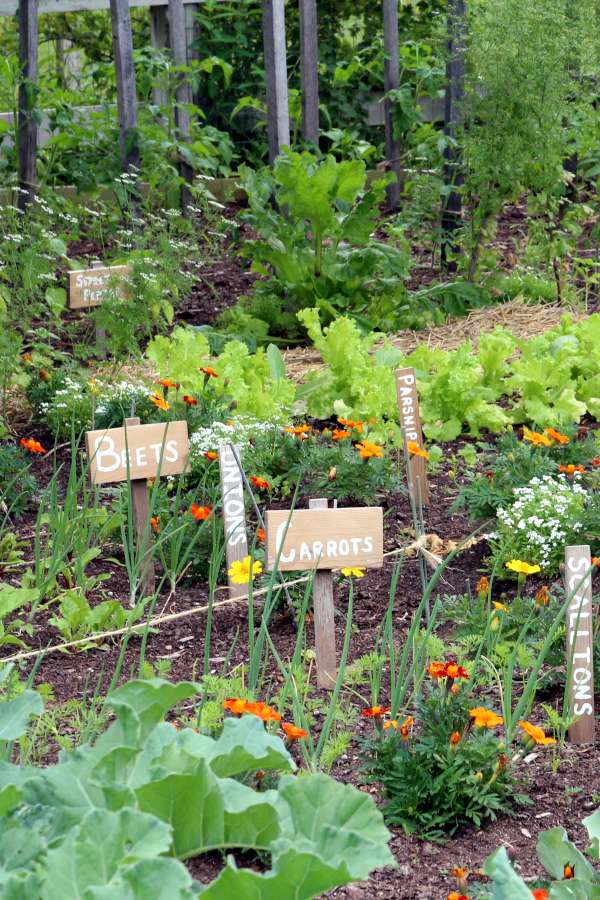
Harvesting and Enjoying the Benefits
Harvesting vegetables and flowers
One of the most satisfying aspects of gardening is harvesting the rewards of your labor. When it comes to vegetables, harvest them at peak ripeness for the best flavor and nutritional value. Flowers, on the other hand, can be harvested at various stages of bloom depending on their intended use, whether for cut flowers or simply to enjoy in the garden.
Utilizing fresh produce and floral arrangements
Freshly harvested vegetables can be used in a variety of delicious recipes, allowing you to enjoy the fruits of your labor in the kitchen. From vibrant salads to comforting soups, the possibilities are endless. Additionally, flowers from your garden can be incorporated into stunning floral arrangements, bringing beauty and fragrance into your home.
Preservation methods for extended enjoyment
If you have a surplus of vegetables or flowers, consider preserving them for later use. Vegetables can be frozen, canned, or dehydrated to extend their shelf life. Flowers can be dried or pressed to create beautiful and long-lasting decorative pieces. By employing preservation methods, you can enjoy the benefits of your flower-vegetable garden throughout the year.
Conclusion
Final thoughts on planting flowers next to vegetables
Planting flowers next to vegetables can be a rewarding and beneficial practice in your garden. Through companion planting, you can create a balanced and harmonious ecosystem that enhances the growth and productivity of your vegetable plants. By selecting appropriate companion plants, considering resource competition, and practicing proper maintenance, you can reap the rewards of beautiful flowers and bountiful harvests.
Summary of benefits and considerations
Companion planting flowers with vegetables offers numerous benefits, including natural pest control, attracting beneficial insects, and enhancing pollination. Popular flower-vegetable combinations such as marigolds and tomatoes, nasturtiums and cucumbers, and lavender and peppers showcase the synergistic relationship between these plants. Creating a thoughtful garden layout, implementing best practices, and addressing potential issues contribute to the success of your flower-vegetable garden. Harvesting the produce and enjoying the beauty of the flowers allows you to fully experience the joys of gardening. So go ahead, plant flowers next to vegetables, and embark on a journey of abundance and beauty in your own backyard.


